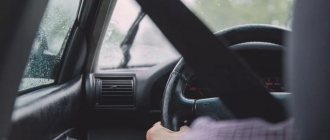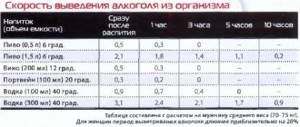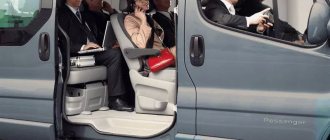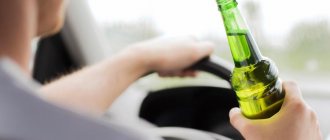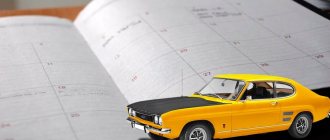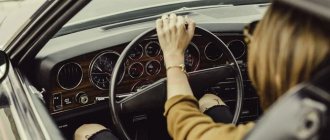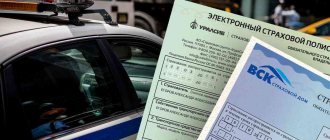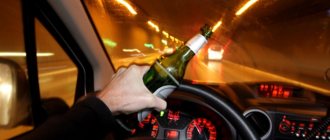How is intoxication determined?
If alcohol is detected in the body above 0.3 ppm, then this indicates that the person is intoxicated. 0.3 ppm is 50 g of vodka, 200 g of wine and 500 g of beer for an average man weighing 80 kg.
If, when tested with a breathalyzer, it was revealed that there is 0.35 ppm of alcohol in a person’s blood, then he is considered drunk. The air exhaled by the driver must contain at least 0.16% ethanol - in this situation the person is considered to be intoxicated.
The issue of the permissibility of drinking non-alcoholic beer while driving is still controversial. Some believe that this drink is harmless, others believe that you should not drink it before a trip. As for police officers and narcologists, the opinion of these specialists is clear: the consequences of excessive consumption of non-alcoholic beer can be catastrophic.
Calculations of ethanol content in non-alcoholic beer
The number 0 on the label of non-alcoholic beer is evil. Because it contains alcohol, even in tiny doses. To be precise, the strength of such a drink ranges from 0.1 to 0.5 percent. This corresponds to approximately 10 grams of vodka in 1 liter of drink. Thus, it can be calculated that a man weighing 70 kg needs to drink 2.6 liters of non-alcoholic beer at once in order for the concentration of alcohol in the blood to reach the critical value of 0.3 ppm, which will be recorded by a breathalyzer.
But there is one more circumstance that can lead to a driver being required to undergo a medical examination after drinking non-alcoholic beer. This is a residual smell. The thing is, the smell of beer hasn't gone away. It is inherent in both regular and non-alcoholic drinks. It's just less persistent after drinking non-alcoholic beer.
More on the topic: Permitted amount of ppm for drivers and the time it takes for alcohol to dissipate
Is it possible to drink non-alcoholic beer while driving?
To understand whether you can drive after drinking non-alcoholic beer, you need to study the composition of the drinks. Both standard and non-alcoholic beer are produced using the same algorithm. The same raw materials are used for production - it is thanks to this that the beer retains its specific taste. However, “non-alcoholic” beer still contains ethanol.
Don't trust labels. Even if the can has the word “non-alcoholic” on it, it’s just an advertisement . Non-alcoholic beer also contains ethanol, although in smaller quantities.
The harm of non-alcoholic beer: who should not drink it
Every person should understand that alcohol and driving are incompatible concepts. Therefore, you shouldn’t even think about whether to drink or not to drink. If you get into a car as a driver, then strictly establish a taboo on the consumption of alcoholic beverages.
We will support the recommendations with medical data. Drinking beer without alcohol has its disadvantages:
- The drink should not be consumed by people who have problems with the liver or pancreas.
- Despite the fact that “nulevka” is considered non-alcoholic, beer is contraindicated for pregnant women and women who are breastfeeding.
- Alcohol, even in small doses, is harmful for stomach ulcers, inflammatory processes or tumors in the intestines.
- The intoxicating drink should not be consumed if a diagnosis of kidney failure has been made.
- Non-alcoholic beer is contraindicated in coding and treatment for alcoholism.
Of course, if we draw a parallel between alcoholic and non-alcoholic beer, then it is better to give preference to a drink with a reduced alcohol content. However, it is important to remember: there are also hops here, which help relax the nervous system. Therefore, its use before traveling by car is not advisable.
Non-alcoholic beer: how soon can you start driving?
If a person drinks 0.5 liters of non-alcoholic beer, then the ethanol level in his body does not exceed the permissible values. The breathalyzer will most likely show zero results, and after 10-15 minutes the smell of alcohol usually disappears .
If the amount you drank was 2 liters, then it is recommended not to drive for at least 2 hours. Finally, if you drank 3 liters, you should not drive. This can lead to problems when meeting with traffic police officers, and to the risk of an emergency on the road.
At the same time, the driver will have a slight smell of fumes even if he drank very little non-alcoholic drink. As a result, this can lead to problems when meeting with traffic police officers.
Can you get drunk from non-alcoholic beer?
It is this question that leads to reflection: “Is it possible for a driver to drink non-alcoholic beer while driving?” After all, it turned out that in terms of technological characteristics, “nulevka” is almost no different from alcoholic beer. It has a similar taste, a similar color, and a similar hop smell. The drink is consumed according to the same principles, with a traditional snack. Therefore, these factors influence the degree of intoxication. In other words, banal self-hypnosis occurs.
It is difficult to predict how the effect will affect a particular driver. For example, a man sat with friends, drank a couple of cans of Nulevka, then drove home in his car. It seemed like what was criminal about this. The driver did not drink alcohol. The blush just appeared, the pupils slightly dilated, and the rhythm of the heartbeat accelerated.
But you need to be prepared, if the traffic police inspector stops you, the situation will be ambiguous. Well, what is the problem? The facts of alcohol consumption will become visible on the face, and even a small percentage of alcohol in the blood will be shown by a breathalyzer. Then it will be pointless to prove that a simple “zero” was drunk.
Experiments by narcologists
One large drug treatment institution conducted an experiment, studying the effects on the body of non-alcoholic beer Clausthaler and Baltika, kvass, kumiss, and natural apple juice. It turned out that even products that are safe and harmless at first glance can cause more problems than non-alcoholic beer, which is still controversial.
The following conditions were met during the study:
- the subjects did not eat anything during the experiment;
- men who differed in weight, physical parameters and immunity were selected as subjects;
- the study was official, the findings were examined by medical specialists.
Before the test, each man was tested for the presence of alcohol in his blood. None of the people tested positive for ethanol . After the test, the specialists used the same breathalyzer. The results were as follows.
| What did you drink? | What quantity | What the breathalyzer showed (in ppm) | |
| Immediately after taking | After 10-15 minutes | ||
| Apple juice | 500 ml | 0,0 | negative indicators indicating the sobriety of the subjects |
| Kumis | 1,04 | ||
| Kvass | 700 ml | 0,0 | |
| "Baltika" | 1 l | 0,09 | |
| Clausthaler | 0,1 | ||
After 15 minutes, specialists interviewed the men, checking their reaction speed and well-being. It was found that the subjects were sober, there was no alcohol in their body, which was determined earlier.
However, immediately after consuming certain drinks, a breathalyzer detected traces of alcohol. The highest levels of alcohol were found in kumys, but the degree of intoxication was mild .
Experts detected a smell of fumes, a rapid pulse, and slightly noticeable disturbances in speech. The subjects' gait became slightly unsteady.
Thus, even if you drank non-alcoholic beer, it is recommended to wait 10-15 minutes rather than get behind the wheel right away. If you are stopped by traffic police representatives a couple of minutes after the start of your trip, this risks leading to problems.
What can a blood test show?
To carry out such an analysis, the amount of blood required for the study is taken from a person’s vein. Typically one of two methods is used:
- Gas chromatography, when 3-5 ml of blood is loaded into a special chamber called a chromatograph. Alcohol is evaporated from the blood plasma, and its content is determined by the amount of ethanol vapor, displayed on the monitor screen of the device. This method is quite accurate, and it is what is used in practice with drivers.
- Enzyme analysis involves the detection of alcohol dehydrogenase, an enzyme that is secreted by the liver after drinking alcohol. If a person drinks, the content of this enzyme increases sharply.
Both methods do not take much time, so a person’s condition can be determined fairly quickly. The results are determined by the following ppm indicators:
- sober state - 0–0.3;
- mild intoxication - 0.3–0.9;
- average intoxication - 0.9–1.9;
- severe intoxication - 2.0–3.3;
- state of torpor - 3.6–3.9;
- The lethal dose is 4.0–5.0.
More on the topic: Road repairs have been completed, but temporary signs have not been removed - is the fine legal?
Blood test readings are considered the most accurate, and positive results of such an analysis can become the basis for the application of liability measures to the driver, including deprivation of rights.
ATTENTION! In order for the devices to determine the state of the minimum stage of intoxication in a person after drinking non-alcoholic beer, he needs to drink at least 3 liters of the drink within about an hour.
What happens if the traffic police stops you?
The following points must be taken into account.
Breathalyzers function in different ways. The following situation is quite : a person drank a little non-alcoholic beer, waited about an hour, went on the road, and when meeting with representatives of the traffic police, the breathalyzer revealed the presence of alcohol to a somewhat inflated degree.
A lot depends on the driver’s body. Some people do not feel the least bit intoxicated, but for others the consequences are more serious. It is not recommended to take risks: even the slightest decrease in concentration can lead to an accident.
If a traffic police representative smells even a faint odor of alcohol, he will conduct a breathalyzer test. But if the device shows a zero result, then the traffic police representative can still refer the driver for a medical examination, which will demonstrate traces of alcohol in the blood. As a result, the driver will lose time, receive a fine, and be faced with the need to pick up his own car from the impound lot.
In addition, a person runs the risk of losing his driver's license. So, drinking non-alcoholic beer while driving is not recommended - the consequences may be too negative.
Will a breathalyzer show the non-alcoholic beer you have drunk?
The technology for producing a soft drink is similar to the production of regular beer. The difference is that in the first case, the ethanol is evaporated, reducing the alcohol concentration. Thus, non-alcoholic beer still contains alcohol, approximately 0.5% . Therefore, the drink is considered only conditionally non-alcoholic.
You can look at the question from a different angle. Alcohol content is also found in regular drinks:
- Kumis: 0.5–2.5%;
- Kefir: 0.02–00.7%;
- Kvass: 0.7–2.5%.
The drinks are actually considered soft drinks, but if consumed in large quantities, the breathalyzer will also show ppm. After all, even a small amount of alcohol is subsequently absorbed into the blood.
It is worth noting that 2-3 cans of conditionally non-alcoholic beer quickly disappear, but the smell remains. For example, if a driver drank a bottle of non-alcoholic beer and was stopped by an inspector, the breathalyzer will not show intoxication. However, if a traffic police officer smells the smell, the driver will have to go for a medical examination.
How many ppm will a can of non-alcoholic beer show? The indicator depends on the brand and production technology of the drink. After one drink of “zero”, the device monitor will show 0.05–0.22 ppm.
Ways to protect yourself
If you have consumed a soft drink, then the following methods will help you hide the “traces of crimes.” First of all, brush your teeth well for at least 5 minutes, use a mouth rinse, a special irrigator for fresh breath.
There are also other means to eliminate the slight smell of alcohol. They act for 15-60 minutes, but in the case of non-alcoholic beer this may be quite enough .
- Take half a lemon, squeeze the juice out of it and add 2-3 drops of vinegar. The resulting solution is used to rinse the mouth.
- Chew nutmeg or roasted coffee beans for a couple of minutes.
- Chew tea leaves, hold them under your tongue or behind your cheek.
- Nibble on the roasted seeds - they also do a good job of eliminating the slight smell of alcohol.
There are special anti-police lollipops. According to manufacturers, they are able to muffle the smell of alcohol, but their duration of action is short. But the affordable cost of lollipops leads to the fact that many drivers use this product when consuming small amounts of alcohol.
Mint chewing gum should not be used - this may enhance the smell of alcohol and arouse suspicion among traffic police officials.
Interesting Facts
Not only non-alcoholic beer can make a person a little “intoxicated”. Other seemingly harmless products also have this ability - for example, fermented milk drinks, sweets with the addition of rum or cognac, kvass. Even bananas can begin the fermentation process - especially those that are overripe and have small black spots on the peel.
Ethanol is also found in cigarettes, especially if they are flavored. Toothpastes, mouth rinses and a number of medications also contain ethanol .
A survey of drivers was conducted: people were asked whether they had to drive after drinking alcohol. Almost half of them answered negatively, because, in their opinion, it is deadly. 2.7% of respondents occasionally drive while slightly drunk. 14.8% of respondents drove a car while heavily intoxicated.
And one day a lover of non-alcoholic beer decided to prove to the public that this drink does not cause the slightest harm to the condition, so it is allowed to be safely consumed by those who drive. The man bought 10 liters of beer and drank it. An hour later, his health sharply worsened from such a volume that suddenly entered the body. However, ethanol had no effect on his condition. After this, the man tested with a breathalyzer, which showed a result of 0.02 ppm. These are insignificant indicators, indicating that the subject is almost completely sober. Despite this, such research was not taken seriously.
According to manufacturers, non-alcoholic beer, if you don’t get drunk with it, is even good for human health. it is highly not recommended for pregnant women to consume it - even such a drink can harm the condition of the child and mother. By the way, you should not drink non-alcoholic beer if you want to get rid of alcohol addiction: even the smell is enough for a former alcoholic to break down and go on a binge again.
Drinking non-alcoholic beer while driving can lead to different consequences, since there are many manufacturers of this drink, and they all have their own beer production technologies.
Experiment with non-alcoholic beer and other drinks
In order to understand the effects of non-alcoholic beer and other drinks on humans, one drug treatment center conducted a formal study. It was decided to conduct the experiment on five experimental subjects.
Each of them was asked to drink 5 different drinks. It was decided to use as samples:
- Non-alcoholic beer of the Clausthaler brand.
- Apple juice.
- Regular store-bought kvass.
- Fresh kumiss.
- Non-alcoholic beer nulevka brand "Baltika".
Why these drinks? Probably due to the fact that everyone actually had a certain degree of fermentation, except for apple juice, of course. It was also possible to conduct experiments on food and tobacco products, but were limited to drinks.
Five male volunteers were selected to conduct the experiment. All applicants had different weight categories, ages, and health. Naturally, before the experiment, they were given a medical examination to ensure that alcohol would not harm their health. Everything is as it should be. The same breathalyzer was used to conduct the experiment and record the results.
Each was provided with the drink described above, namely:
- One liter of zero water.
- 0.7 liters of kvass from the store.
- 2 bottles of 0.5 l of Clausthaler beer.
- Half a liter of kumys.
- 0.5 liters of fresh apple juice.
After 15 minutes, each subject was not only taken with a breathalyzer, but also their general condition and reaction were additionally checked, and the men were asked various questions.
The results may seem strange to some, but all the experimental subjects turned out to be 100% sober. That is, this proves that only 15 minutes are enough for any “non-alcoholic” drink to disappear.
Experience No. 2
The research didn't stop there. It was decided to continue the experiments, but with some changes. This time everything was the same, but the breathalyzer readings were taken immediately after consuming the product.
The results, to put it mildly, shocked everyone:
- Kumis has an alcohol percentage of 1.04.
- Non-alcoholic beer Clausthaler has only 0.1%.
- The Baltic has zero levels – 0.09%.
- Apple juice and kvass have 0.00%.
When considering the data obtained, you can see that the person who drank 1 liter of kumiss was mildly intoxicated. From a medical point of view, it starts at 1.5%. That is, in fact, koumiss contains more alcohol as such than any non-alcoholic beer.
On the other hand, the experimental subject who drank beer, in a total volume of 2 liters, also became slightly intoxicated. This was expressed in slightly incoherent speech, fumes, rapid pulse and a slightly unsteady gait.

